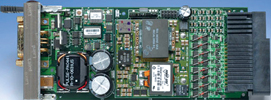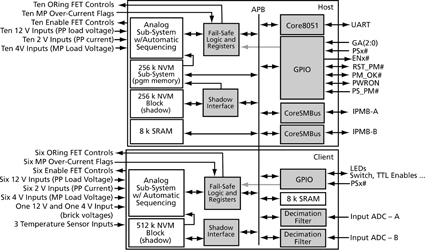
Telecommunications computing architecture (TCA) standards are defined by the PCI Industrial Computer Manufacturers Group (PICMG). AdvancedTCA (ATCA) is a 2002 PICMG standard that defines an architecture for high-performance, high-density, packet-based systems.
In 2005, PICMG published the Advanced Mezzanine Card (AMC) specification, which extends ATCA's high-bandwidth, multiprotocol interface to hot-swappable modules, resulting in easy design, scaling, and servicing. In 2006, PICMG released the MicroTCA (μTCA) standard. MicroTCA is focused on a smaller form factor chassis to reduce the cost for lower bandwidth, high availability systems. Both ATCA and MicroTCA embrace the Intelligent Platform Management Interface (IPMI) protocol, introduced for server blades by Intel in 1995 and then expanded to board- and system-level management applications. ATCA and MicroTCA are architected so that the AMC is compatible and interchangeable between the two systems.
Programmable logic solutions company Actel is developing a fully-compliant MicroTCA management solution based on its Fusion devices - its latest Flash-based, mixed-signal FPGA technology. Actel will deliver complete hardware, software, and IP platform reference designs for the basic MicroTCA management elements for the advanced mezzanine card (MC), power module (PM), MicroTCA carrier hub (MCH), and cooling unit (CU). The goal is to provide customers with solutions that are modular, compact, and low cost, and easy to customise, maintain, and re-use.
Actel solution
The Actel Fusion FPGA is an ideal platform for system management in a MicroTCA module. Actel supports Fusion-based MMC and EMMC solutions with fully-coded reference designs. Each reference design includes an embedded processor and interface intellectual property (IP) cores, IPMI software, and customisation services. The nature of the reference designs enables quicker time to market, reduced risk, and low costs, as well as improved performance and advanced functionality, improved reliability, and high availability.
This support is intended to help Actel customers use the reference design as is or as a starter to customise their own designs. While the MicroTCA standard is intended to reduce the cost of telecoms and data networking systems, it may also propel new architectures and innovations in industrial, medical, and military equipment.
Similar to replacement of the mini-computer by the personal computer, a variety of electronic systems will benefit from targeting a modular, low cost, high availability MicroTCA chassis. To demonstrate that Fusion devices can perform as a platform for MMC and EMMC solutions, Actel has created turnkey reference designs for a MicroTCA PM and an AMC. The MicroTCA PM reference design (Figure 1) includes Verilog code for the FPGA design, ANSI-C code for an embedded 8051 processing core (including routines to support the necessary IPMI protocol), module level schematics and layout files, and the associated bill-of-materials.

Power module implementation and benefits
Two Actel Fusion (AFS600) devices are used in the Actel MicroTCA power module to perform EMMC functions. The EMMC directly supports: 36 voltage measurements; 16 current measurements; three temperature monitors; power channel control; hardwired circuit protection; dual IPMB-0 Interfaces (I2C); IPMI commands, including FRU ROM and optional SEL/SDR.
The Actel EMMC design is a highly integrated solution that resolves many engineering problems in a power module design. These include challenges such as high analog/digital I/O counts, 100 μs response time requirements for fail-safe and switchover circuits, congested board layout with many discrete components, and remote in-system upgrade capability.
Other MicroTCA solutions
The Actel Power Module reference design shows that Fusion is an ideal choice for EMMC and MicroTCA system management implementations. Building on the power module, Actel will also provide an advanced mezzanine card solution (MMC), a cooling unit solution (EMMC-II), and a carrier hub solution (MCMC).

In brief
Using Actel Fusion devices as the core of the MicroTCA power module design drastically reduces component count on the board, simplifies the assembly process, and so reduces overall cost. The power module redundancy feature boosts system reliability to 0,99999. The modularised design approach allows customers to take the Actel power module design and software and easily customise it to meet their unique requirements. Platform similarity among the MicroTCA basic elements also gives customers the opportunity to port the power module EMMC design into cooling unit designs and AdvancedMC designs, with appropriate hardware or software changes. The Actel MicroTCA power module solution is fully compliant to MicroTCA specifications and greatly reduces product development effort.
| Tel: | +27 11 315 8316 |
| Email: | [email protected] |
| www: | www.asic.co.za |
| Articles: | More information and articles about ASIC Design Services |

© Technews Publishing (Pty) Ltd | All Rights Reserved